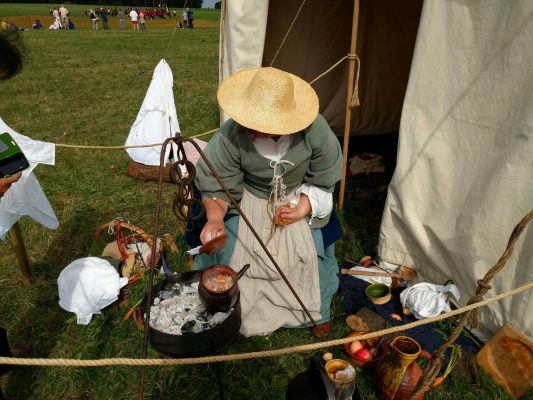I was fortunate enough to be one of the select few speaking at the English Civil War Living History Symposium at Pitchford Hall this weekend. There were several fascinating talks all aimed at deepening our understanding of 17th century life and also how we deliver Living History events. My thanks to Sue Sampson who organised the Symposium and to Ken Clayton who marshalled the speakers in the hall.

Living History Symposium
Campsite Activities
These were mostly hands-on practical activities.
- Sewing bee (Carolyn Richardson & Sue Sampson)
- Music & Dancing
- Have a go blacksmithing (David Best)
- Around the World with 17th Century Spices (Sue Ball)
- Wool Production: spinning & spinning wheels – early to mid 17th century (Jos Richards * Sue Sampson)
- Painting miniatures (Mike Richards)
- Fire & Lighting, from spark to flame (Gary McCann)
- Sword School (Chris Ball)
- Etiquette of Fine Dining (Phil Staker)
- Playing the lute – hands-on practice (Carolyn Richardson)
- Money, income and wages in the mid-17th century (Paul Cramer)
- Soldier’s show and tell with weapons – how to do it safely (Mary McDonald-Watson)
Talks in the Hall

- Cooking and Cooking Utensils in the mid 17th Century (Stuart Peachy & Gilly Morley)
- Research: Why it is important and how to do it properly (Ken Clayton)
- The Importance of Living History in Re-enactment: how to do it well (Steve Southcoat)
- The Gentle Art of Playing the Lute: Theory (Carolyn Richardson)
- Scripting First Person Living History Scenarios (James Kemp)
- Clothes of the common sort in the mid 17th century (Stuart Peachy & Gilly Morley)
- The Problem with Woodcuts: why the majority are unreliable (Stuart Peachy & Gilly Morley)
My impressions
I spent most of my time in Pitchford Hall itself as that was where I was presenting. So I heard the Stuart Peachy talk on food, Ken Clayton’s talk on research, Steve Southcoat on the importance of Living History and Carolyn Richardson on the Lute.
Over on the campsite I saw a little of David Best demonstrating blacksmithing, and talked more with some of the participants.
Stuart Peachy on Food
Stuart Peachy is well known amongst the living history community as an experimental archaeologist. That’s to say he takes what he reads and gives it a go to understand it better. So his talk was a mix of what the period sources tell us and the results of his experience with preserving food.
I missed the start, but came in to the discussion on pig husbandry. Pigs being a mechanism for turning food waste back into food. Think of it as an early form of recycling and waste reduction. The practical point of this is that pig husbandry practice was different in the 17th century than the early 21st. Today we produce food for pigs so we can make lots of pork products. Back then they only kept enough pigs to consume the waste they produced. Out of each litter the weakest few would be killed immediately, of the five allowed to suckle two would become suckling pig to be consumed as a delicacy for the gentry. The remaining would be kept while there was food and then slaughtered and preserved over a month or two. The offal would be used fresh and the rest salted or smoked.
There was loads more on traditional meat products and who are them and when they tended to be available. Enough to keep dozens of blog posts full to the brim.
Key point is that there’s a more deliberate approach to food. Things are preserved with practically inedible levels of salt, so they need soaked for a day or so before being used. Food prep takes longer and there is advance planning needed. Mostly we should be making tomorrow’s meals…
Other talks
I’m hoping to be able to host at least some of the talks/handouts and have asked the participants if they will let me share them. I’ll post them up as and when they become available over on https://www.civilwars.org.uk/












